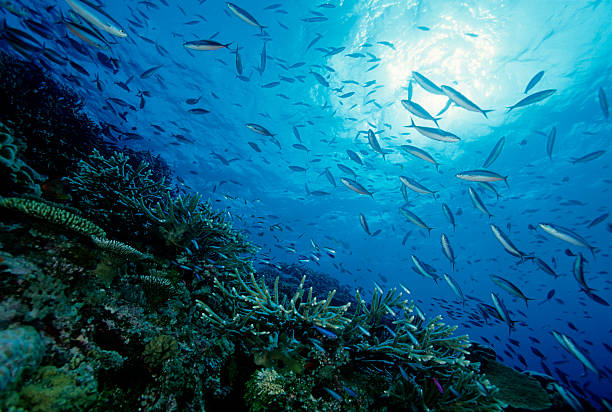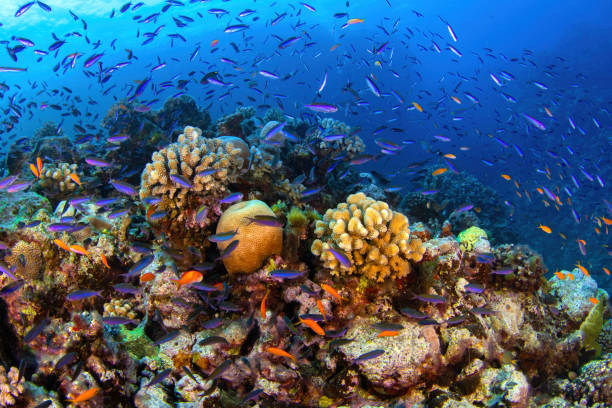The Great Barrier Reef, a majestic natural treasure located off the coast of Queensland, Australia, is the largest coral reef system in the world. This vibrant underwater ecosystem is renowned for its stunning biodiversity, making it a hotspot for marine life and a focal point for conservation efforts. Home to thousands of species of flora and fauna, the Reef provides an extraordinary glimpse into the lives of creatures ranging from the minuscule plankton to the majestic humpback whale. Exploring this underwater paradise, one can not only revel in its beauty but also understand the critical importance of preserving one of the most unique and delicate ecosystems on our planet.
The Diversity of Coral Species

The foundation of the Great Barrier Reef is its vast array of coral species, each playing an integral role in the marine ecosystem. Over 600 types of corals can be found in these waters, including both hard and soft corals. Hard corals, such as brain and staghorn corals, construct the sturdy skeletons that form the backbone of the reef. Soft corals, like sea fans and whips, sway with the currents, adding movement and color to the seascape. The intricate structures of these corals not only create a safe haven for countless marine species but also induce the reef’s overall resilience through their unique life cycles and reproductive strategies. The reef’s health is a delicate balance maintained by these corals, and their continued existence is vital to the reef’s future.
Marine Creatures Great and Small
Within the complex matrix of coral lie myriad creatures of the sea, each with its own niche and function. Vibrant schools of fish, such as parrotfish, clownfish, and angelfish, dart among the corals, adding splashes of color to the underwater landscape. Larger predators, like the sleek reef shark and the barracuda, patrol the waters, ensuring a balance within this aquatic community. Even the smallest organisms, like zooplankton, play a significant role as they form the base of the reef’s food chain. The Great Barrier Reef is also a sanctuary for endangered species, including the green sea turtle and the dugong, which feed on the abundant seagrass beds that fringe the reef.
Significant Symbiotic Relationships
One cannot discuss marine life in the Great Barrier Reef without highlighting the intricate symbiotic relationships that are the bedrock of this ecosystem. The mutualistic partnership between coral polyps and zooxanthellae algae is particularly fascinating. The algae reside within the coral, providing it with nutrients via photosynthesis, while the coral, in turn, offers the algae a protected environment and compounds necessary for photosynthesis. This relationship not only enables the coral to thrive but is also crucial for the reef’s growth and energy production. Other examples of symbiosis include the clownfish and anemones, where each species benefits from the other’s presence for protection and sustenance.
The Importance of Conservation
While the Great Barrier Reef is a hub of marine biodiversity, it also faces significant threats from climate change, pollution, and overfishing. Rising water temperatures have led to widespread coral bleaching events, where the vital symbiotic algae are expelled from the coral, leaving it weak and vulnerable to disease. Efforts to reduce carbon emissions, regulate fishing practices, and minimize pollution are imperative to protect this valuable ecosystem. Global awareness and action are required to ensure that the Reef continues to thrive for future generations. Preservation of this natural wonder is not just about safeguarding biodiversity, but also about maintaining the health of our oceans and the planet as a whole.
The Appeal for Eco-Tourism
Eco-tourism plays a significant role in the sustainability of the Great Barrier Reef by fostering appreciation and financial support for its preservation. Visitors from around the world come to witness the reef’s magnificence, often leaving with a heightened understanding of its importance and vulnerability. Besides providing educational experiences, eco-tourism generates income that can be directed towards conservation efforts. It’s crucial, however, that this tourism is managed responsibly to ensure that it does not contribute to the degradation of the ecosystem it aims to protect. Practices such as controlled visitor numbers, proper waste management, and guidelines for respectful wildlife interaction are essential components of sustainable eco-tourism in the region.
Conclusion
The Great Barrier Reef is an unparalleled marine biodome, boasting an array of life forms that is as diverse as it is captivating. From the tiniest zooxanthellae to the largest whales, each species contributes to the delicate balance of this vibrant ecosystem. The human responsibility to preserve and protect this natural marvel is substantial, as it faces the dire threats of climate change and human-induced stresses. Through conservation efforts and sustainable eco-tourism, we can all contribute to the longevity and health of the Reef, ensuring it remains a wonder of the natural world for generations to come. The future of the Great Barrier Reef is not just in the hands of conservationists and scientists, but in those of every individual who values the richness and diversity of life on Earth.
FAQs
-
How large is the Great Barrier Reef?
The Great Barrier Reef spans approximately 2,300 kilometers (over 1,400 miles), making it the world’s largest coral reef system.
-
Can you see the Great Barrier Reef from space?
Yes, the Great Barrier Reef is one of the few living structures on Earth that is visible from space.
-
What are the major threats to the Great Barrier Reef?
Major threats to the Reef include climate change-induced coral bleaching, ocean acidification, overfishing, coastal development, and water pollution from agricultural runoff.
-
What can I do to help protect the Great Barrier Reef?
Individual actions can include reducing carbon footprint, supporting sustainable seafood, avoiding single-use plastics, and advocating for marine conservation policies.
-
Is the Great Barrier Reef dying?
While the Great Barrier Reef is under stress, it is not dying. There are vast areas still teeming with life, but its future depends on immediate and sustained conservation efforts.
